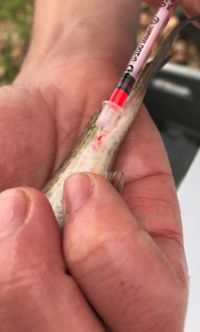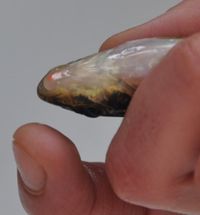Difference between revisions of "Visible implant elastomer"
Bendikhansen (talk | contribs) |
|||
| (35 intermediate revisions by 2 users not shown) | |||
| Line 1: | Line 1: | ||
| + | [[file:vie_implant_2.jpg|thumb|200px|Figure 1. Injection of visible implant elastomer (NMT)]][[file:vie_implant_3.jpg|thumb|200px|Figure 2: Example of VIE inside fish (NMT)]] | ||
=Quick summary= | =Quick summary= | ||
| − | Developed by: | + | Developed by: Northwest Marine Technology, Inc. |
Date: | Date: | ||
Type: [[:Category:Devices|Device]] | Type: [[:Category:Devices|Device]] | ||
| − | |||
| − | |||
=Introduction= | =Introduction= | ||
Visible Implant Elastomer (VIE) Tags are coloured tags (https://www.nmt.us/visible-implant-elastomer/). They are implanted in translucent tissue of several animals, mainly used in fish, but also in crustaceans, cephalopods, reptiles, amphibians, small mammals, etc. (Figure 1). VIE consists of two liquid components (colour component and curing agent) which are mixed just before the tagging, changing into a solid state in a short time (1-2 hours). VIE are injected subcutaneously with syringes or specialist injection systems in clear tissue areas, and there are several colours available, with and without fluorescence. | Visible Implant Elastomer (VIE) Tags are coloured tags (https://www.nmt.us/visible-implant-elastomer/). They are implanted in translucent tissue of several animals, mainly used in fish, but also in crustaceans, cephalopods, reptiles, amphibians, small mammals, etc. (Figure 1). VIE consists of two liquid components (colour component and curing agent) which are mixed just before the tagging, changing into a solid state in a short time (1-2 hours). VIE are injected subcutaneously with syringes or specialist injection systems in clear tissue areas, and there are several colours available, with and without fluorescence. | ||
| − | |||
| − | |||
=Application= | =Application= | ||
| − | + | The main goal of tagging with VIE is the visual recognition of individuals (Figure 2). This can be achieved with a unique code, depending on the number of animals, colours and tagging places available. Obtaining results is based on mark and recapture techniques, and usually as a complement of another tracking system. The main application is focused on temporary habitat use studies. In the case of fishways, tagging fish downstream, upstream and inside the fishway, and recapturing some of them, can provide information about their movements. | |
| − | The main goal of tagging with VIE is the visual recognition of individuals. This can be achieved with a unique code, depending on the number of animals, colours and tagging places available. Obtaining results is based on mark and recapture techniques, and usually as a complement of another tracking system. The main application is focused on temporary habitat use studies. In the case of fishways, tagging fish downstream, upstream and inside the fishway, and recapturing some of them, can provide information about their movements. | ||
In contrast to other tag devices smaller individuals (even less than five centimetres) can be tagged with VIE and the cost per tag is quite low (€ cents per tag per millilitre of product and day of tagging). However, about costs, it is necessary to also take into account the need for fish samples, or video recording devices that are required for the recaptures | In contrast to other tag devices smaller individuals (even less than five centimetres) can be tagged with VIE and the cost per tag is quite low (€ cents per tag per millilitre of product and day of tagging). However, about costs, it is necessary to also take into account the need for fish samples, or video recording devices that are required for the recaptures | ||
| + | |||
| + | =Relevant mitigation measures and test cases= | ||
| + | {{Suitable measures for Visible implant elastomer}} | ||
=Other information= | =Other information= | ||
More information about range size and species with links to research papers can be found here: https://www.nmt.us/versatile-vie/ | More information about range size and species with links to research papers can be found here: https://www.nmt.us/versatile-vie/ | ||
There are other types of tags with similar characteristics and/or applications. For example: VI Alpha tags (https://www.nmt.us/vi-alpha/), Anchor tags (https://www.hallprint.com/), piercing tags (https://nationalband.com/fish-tags/). | There are other types of tags with similar characteristics and/or applications. For example: VI Alpha tags (https://www.nmt.us/vi-alpha/), Anchor tags (https://www.hallprint.com/), piercing tags (https://nationalband.com/fish-tags/). | ||
| − | |||
=Contact information= | =Contact information= | ||
https://www.nmt.us | https://www.nmt.us | ||
=Relevant literature= | =Relevant literature= | ||
| − | + | *Hohn, C., Petrie-Hanson, L.(2013)Evaluation of visible implant elastomer tags in zebrafish (Danio rerio)Biology Open 2: 1397-1401; https://doi.org/10.1242/bio.20136460 | |
| + | *Jacoby, D.M.P., Fear, L.N., Sims, D.W., Croft, D.P.(2014) Shark personalities? Repeatability of social network traits in a widely distributed predatory fish. Behav Ecol Sociobiol 68, 1995–2003 . https://doi.org/10.1007/s00265-014-1805-9 | ||
[[Category:Devices]] | [[Category:Devices]] | ||
Latest revision as of 13:05, 1 June 2020
Contents
Quick summary
Developed by: Northwest Marine Technology, Inc.
Date:
Type: Device
Introduction
Visible Implant Elastomer (VIE) Tags are coloured tags (https://www.nmt.us/visible-implant-elastomer/). They are implanted in translucent tissue of several animals, mainly used in fish, but also in crustaceans, cephalopods, reptiles, amphibians, small mammals, etc. (Figure 1). VIE consists of two liquid components (colour component and curing agent) which are mixed just before the tagging, changing into a solid state in a short time (1-2 hours). VIE are injected subcutaneously with syringes or specialist injection systems in clear tissue areas, and there are several colours available, with and without fluorescence.
Application
The main goal of tagging with VIE is the visual recognition of individuals (Figure 2). This can be achieved with a unique code, depending on the number of animals, colours and tagging places available. Obtaining results is based on mark and recapture techniques, and usually as a complement of another tracking system. The main application is focused on temporary habitat use studies. In the case of fishways, tagging fish downstream, upstream and inside the fishway, and recapturing some of them, can provide information about their movements. In contrast to other tag devices smaller individuals (even less than five centimetres) can be tagged with VIE and the cost per tag is quite low (€ cents per tag per millilitre of product and day of tagging). However, about costs, it is necessary to also take into account the need for fish samples, or video recording devices that are required for the recaptures
Relevant mitigation measures and test cases
Other information
More information about range size and species with links to research papers can be found here: https://www.nmt.us/versatile-vie/ There are other types of tags with similar characteristics and/or applications. For example: VI Alpha tags (https://www.nmt.us/vi-alpha/), Anchor tags (https://www.hallprint.com/), piercing tags (https://nationalband.com/fish-tags/).
Contact information
Relevant literature
- Hohn, C., Petrie-Hanson, L.(2013)Evaluation of visible implant elastomer tags in zebrafish (Danio rerio)Biology Open 2: 1397-1401; https://doi.org/10.1242/bio.20136460
- Jacoby, D.M.P., Fear, L.N., Sims, D.W., Croft, D.P.(2014) Shark personalities? Repeatability of social network traits in a widely distributed predatory fish. Behav Ecol Sociobiol 68, 1995–2003 . https://doi.org/10.1007/s00265-014-1805-9

